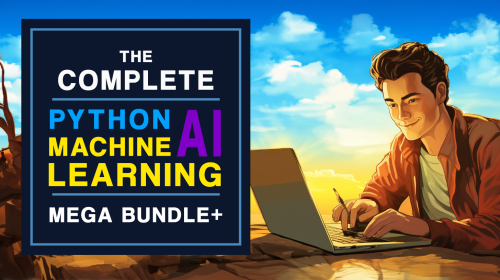
How to make an AI on your computer. Man-made brainpower (man-made intelligence) has upset different businesses, from medical services to funds, and in the middle between. But have you ever wondered how you can create your own AI right on your computer? It’s more manageable than it might seem. This guide will walk you through the process step-by-step, from understanding the basics to building and deploying your first AI model.
How To Make An Ai On Your Computer
Getting Started
Basic Requirements
Before diving into AI development, there are a few basic requirements you’ll need:
- A Computer: Preferably with a good amount of RAM and a decent processor.
- An Internet Connection: For downloading libraries and accessing online resources.
- Basic Programming Knowledge: Familiarity with any programming language is helpful, but not mandatory.
Understanding the Basics of Machine Learning
AI is a subset of computer-based intelligence that spotlights building frameworks that gain from information. It involves various algorithms and statistical models to enable machines to improve their performance on a specific task.
1. Choosing the Right Programming Language
Python: The Go-To Language for AI
Python is the most popular language for AI development due to its simplicity and the vast number of libraries and frameworks available. Libraries like TensorFlow, Keras, and PyTorch make it easier to build and train models.
Other Popular Languages for AI Development
While Python is dominant, other languages like R, Java, and C++ also have their uses in AI, especially for specific applications and performance-critical tasks.
2. Setting Up Your Development Environment
Installing Python
First, you’ll need to install Python. You can download it from the authority Python site. Try to add Python to your framework’s Way during establishment.
Setting Up a Virtual Environment
A virtual climate permits you to oversee conditions for your venture. To set it up:
Bash code
pip install virtualenv
virtualenv ai_env
source ai_env/bin/activate
Installing Necessary Libraries
When your virtual climate is dynamic, introduce the vital libraries:
Bash code
pip install numpy pandas scikit-learn tensorflow keras
3. Understanding Machine Learning Algorithms
Supervised Learning
In regulated learning, the model gains from named information. It’s utilized for undertakings like grouping and relapse.
Unsupervised Learning
Unsupervised learning deals with unlabeled data and is used for clustering and association tasks.
Reinforcement Learning
Reinforcement learning is about training models to make sequences of decisions by rewarding positive outcomes and penalizing negative ones.
4. Data Collection and Preparation
Finding Quality Data
High-quality data is crucial for training effective AI models. You can find datasets from sources like Kaggle, UCI Machine Learning Repository, and public databases.
Cleaning and Preprocessing Data
Raw data often contains noise and missing values. Cleaning involves removing or filling these gaps, and preprocessing may include normalization or scaling.
5. Building Your First AI Model
Choosing a Simple Project
For beginners, it’s best to start with a simple project like predicting house prices or classifying emails as spam or not spam.
Step-by-Step Guide to Building a Model
- Load the Information: Use pandas to stack your dataset.
- Explore the Data: Understand the structure and characteristics of the data.
- Preprocess the Data: Clean and prepare the data for modeling.
- Choose a Model: Start with a basic model like Linear Regression or Decision Tree.
- Train the Model: Fit the model on your training data.
- Evaluate the Model: Check its performance on the test data.
6. Training Your AI Model
Splitting Data into Training and Testing Sets
To avoid overfitting, split your data into training and testing sets, typically in an 80/20 ratio.
Training the Model
Use the training data to train your model. For example:
Python code
from sklearn.model_selection import train_test_split
from sklearn.linear_model import LinearRegression
X_train, X_test, y_train, y_test = train_test_split(X, y, test_size=0.2)
model = LinearRegression()
model.fit(X_train, y_train)
Evaluating Model Performance
Evaluate your model using metrics like accuracy, precision, recall, and F1 score.
7. Improving Model Accuracy
Hyperparameter Tuning
Adjusting the hyperparameters of your model can significantly improve its performance. Use techniques like Grid Search or Random Search.
Using Advanced Algorithms
As you gain more experience, experiment with advanced algorithms like Random Forests, Gradient Boosting, and Neural Networks.
Deploying Your AI Model
Saving the Model
Save your trained model using libraries like joblib or pickle.
Python code
import joblib
joblib.dump(model, 'model.pkl')
Integrating with Applications
Deploy your model in a web application using frameworks like Flask or Django.
8. Using AI Frameworks
Introduction to TensorFlow
TensorFlow is a popular open-source framework for machine learning and AI. It provides comprehensive tools to build and train models.
Using PyTorch
PyTorch is another powerful framework, known for its flexibility and dynamic computation graph.
9. Ethical Considerations in AI
Bias in AI
Man-made intelligence frameworks can acquire predispositions present in the preparation of information. It’s important to identify and mitigate these biases to ensure fair outcomes.
Ensuring Data Privacy
Respect user privacy and comply with data protection regulations when collecting and using data.
10. Troubleshooting Common Issues
Debugging Model Errors
Identify and fix errors in your model by reviewing logs and using debugging tools.
Handling Data Issues
Ensure your data is clean and well-prepared to avoid issues during model training.
11. Resources for Continued Learning
Online Courses
Platforms like Coursera, Udemy, and edX offer comprehensive AI and machine learning courses.
Books and Publications
Books like “Active AI with Scikit-Learn, Keras, and TensorFlow” by Aurélien Géron are fantastic assets.
AI Communities
Join online communities like Reddit’s r/MachineLearning, Stack Overflow, and GitHub to connect with other AI enthusiasts.
How To Make AI Using In USA Online. Read More... Conclusion
Building an AI on your computer is an exciting and rewarding journey. By following the means illustrated in this aide, you can go from a novice to a man-made intelligence designer. Remember, the key to success is continuous learning and experimentation. In this way, continue investigating, continue to construct, and above all, have a great time!


